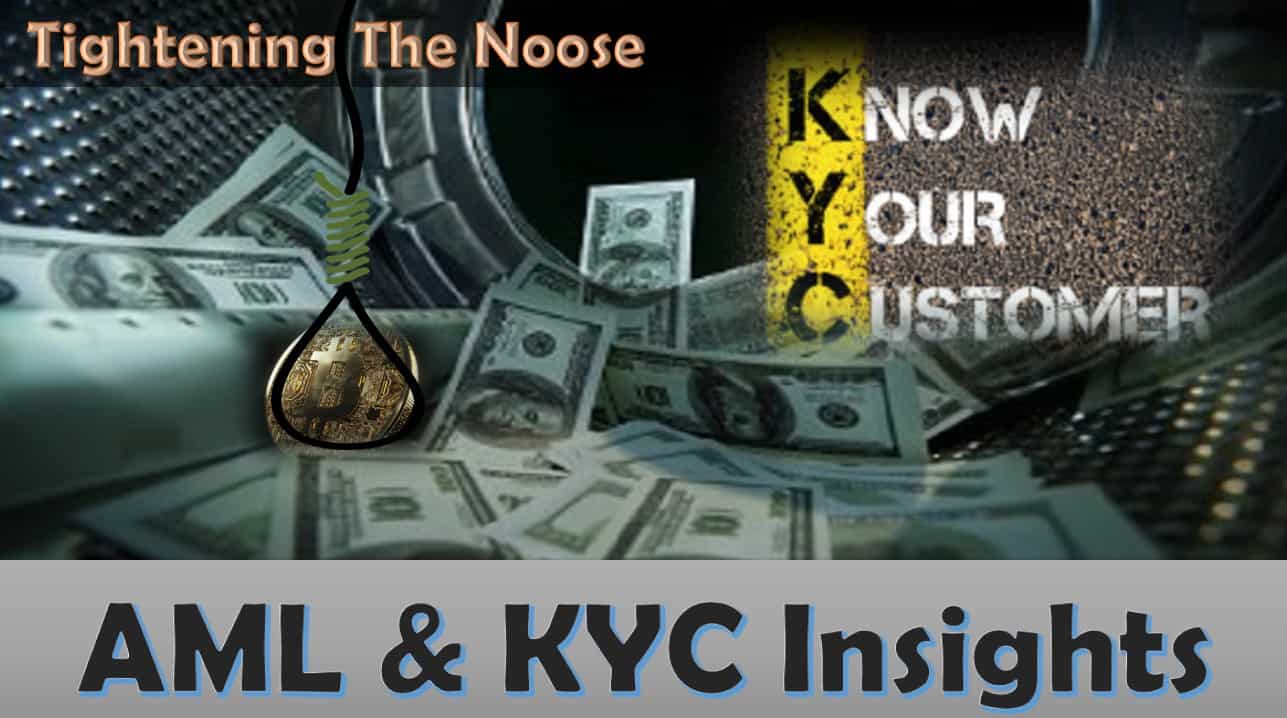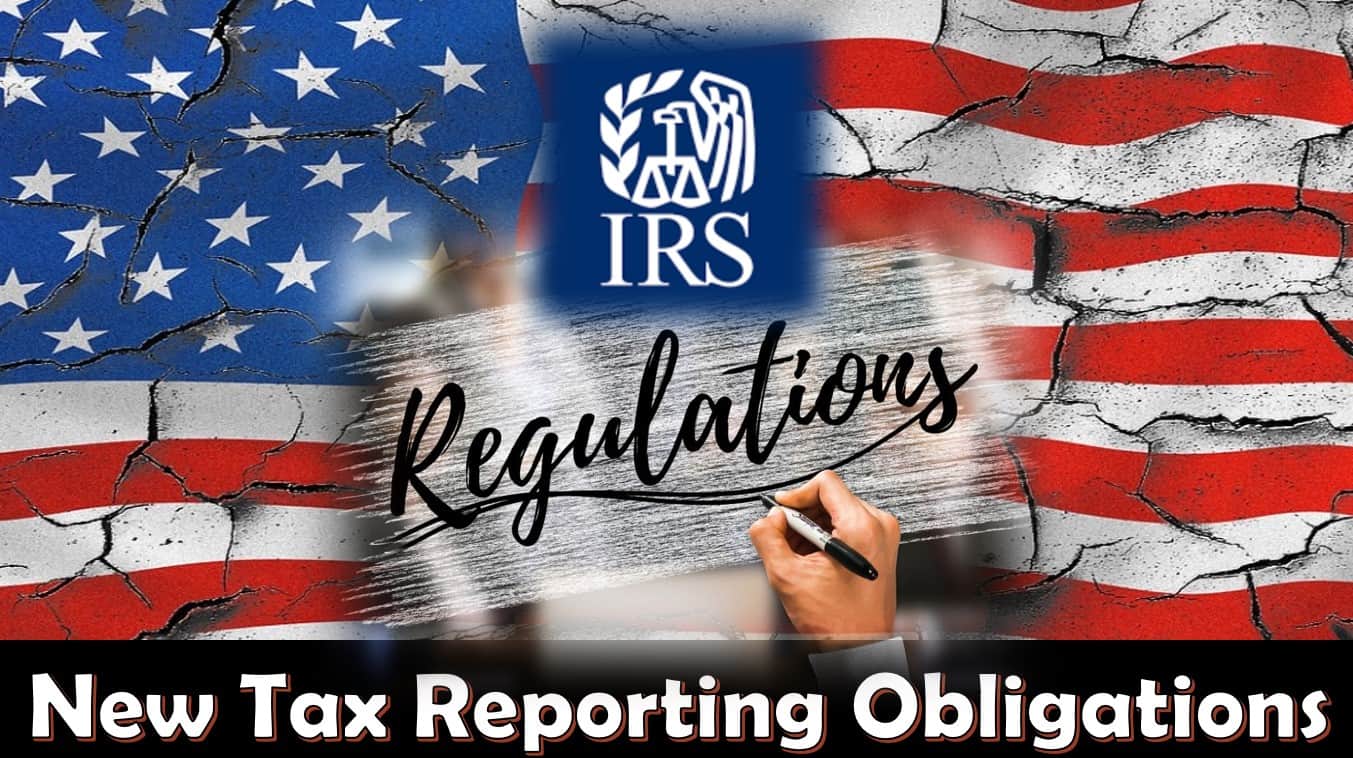
Tightening The Noose: Insights Into KYC and AML Procedures
Last updated on June 8th, 2023 at 02:41 pm
When it comes to understanding Anti-Money Laundering (AML) and Know Your Customer (KYC) regulations you can often be left wondering, “What did I just read?”
Afterall, these topics are pretty boring, and filled with complex terminology, and frankly, often carried out in a bland, academic manner.
However, don’t switch off just yet, because today we’re going to explore these topics in a fresh, witty and informative way. I will attempt to get the basics across to you so “even a caveman can understand it.”
We’ll start by examining how traditional financial institutions use KYC and AML compliance in an attempt to prevent financial crimes, before delving into the exciting world of cryptocurrency, and the ways these regulations affect investors in the space.
However, before we start, let’s get the more academic definitions out of the way.
Anti-Money Laundering (AML) is a set of procedures, laws, and regulations aimed at preventing the illegal exploitation of financial systems for criminal purposes. The Financial Action Task Force (FATF), is the most significant international body responsible for setting and implementing AML regulations. In the United States, the Bank Secrecy Act (BSA) of 1970, as amended by the Patriot Act of 2001, and updated again in 2020, is the primary statutory framework for AML. AML is an effort by national and international bodies to mitigate the financial and economic impact of criminal activities such as fraud, corruption, drug trafficking, terrorism financing, and other transnational crimes.
Know Your Customer (KYC), also referred to as Customer Identification Program (CIP) is a set of procedures, policies, and regulations that financial institutions must implement to verify the identity of their clients and assess their risk profile. This is carried out by completing Customer Due Diligence (CDD) and for high risk customers, Enhanced Due Diligence (EDD). Guidance on KYC requirements are provided by The Financial Action Task Force (FATF) and the Financial Crimes Enforcement Network (FinCEN). In the United States, the Bank Secrecy Act (BSA) of 1970, as amended by the USA Patriot Act of 2001, and updated again in 2020, establishes KYC regulatory requirements.
So, now that we’ve got the basics out of the way, let’s finally jump into this world of AML and KYC compliance.
With recent advances in technology and law enforcement, financial institutions are increasingly turning to advanced analytics tools to identify suspicious activity and ensure compliance with AML and KYC regulations.
So, let’s have a look at how it all works.
AML/KYC Table of Contents:
- Understanding AML & KYC
- Banking System Compliance
- AML and KYC in Cryptocurrency
- Future of AML & KYC
- AML/KYC Compliance Conclusion
- Frequently Asked Questions (FAQ)
Understanding AML & KYC
Let’s face it, deep down we all want to believe that when the government creates a law or imposes some regulation that they are doing so in the best interest of you and me… their citizens.
Though history is replete with alternative examples, we can still hope… right?
So, what does AML and KYC do for us?
Layman’s Definition of AML & KYC
AML stands for Anti Money Laundering, and KYC stands for Know Your Customer.
Put simply, AML regulations are designed to prevent people from using the financial system to launder, hide, or use money gained from illegal activities.
With these laws in place, financial institutions have a framework to take proactive measures to ensure they are only doing business with legitimate customers.
That’s where KYC comes in… by requiring proof of identity (e.g. driver’s licenses, passports), financial institutions can know who exactly they’re dealing with and make sure that the customer is not involved in any criminal activities.
In this way, AML & KYC regulations are supposed to work together to create a financial system that allows honest citizens to safely participate in the global economy.
Seems simple enough…
After all, we can’t have nefarious characters running amok with the world’s finances!
Whether it works as intended or not is something we will discuss later on.
AML & KYC Origins and Legal Frameworks

As I mentioned earlier, The Financial Action Task Force (FATF), is the most significant international body responsible for setting and implementing global AML and KYC standards.
As far as the U.S. is concerned, the Bank Secrecy Act (BSA) of 1970, as amended by the Patriot Act of 2001, as well as further updates in 2020, are the primary statutory framework for AML.
To make sure these regulations are adhered to, financial institutions are utilizing advanced analytics tools to identify suspicious activity.
These tools analyze large amounts of customer data in order to detect patterns that may indicate potential money laundering or other criminal activities.
The training and oversight of these operations is completed by the Federal Financial Institutions Examination Council (FFIEC). This is carried out on a day to day basis by a BSA compliance officer designated at each bank.
So, there you have it, the basics of what AML and KYC is supposed to accomplish.
But how effective have these measures been in preventing money laundering and other financial crimes?
Failures of AML & KYC
All things being equal, it’s hard to argue with the logic behind anti-money laundering (AML) and Know Your Customer (KYC).
After all, who doesn’t want a clean and transparent financial system?
But as we’ve seen in recent years, AML & KYC regulations have failed spectacularly in preventing major money laundering cases.
Take the 1MDB scandal for example, where Malaysian officials were found to have stolen over 4.5 Billion dollars from a state-run fund.

Despite obvious red flags, banks such as Goldman Sachs and JPMorgan Chase continued to process the suspicious transactions without properly investigating them or flagging them for potential money laundering.
What’s more, these banks were found to have violated AML & KYC laws in numerous other cases, such as the Panama Papers scandal and the HSBC money laundering case.
Clearly, there’s something wrong with the way we’re enforcing (or rather not enforcing) AML & KYC regulations.
If our financial institutions can’t be trusted to keep our money safe, then who can we trust?
ANSWER:
Trust Yourself & Trust Cryptocurrency – Learn To UNBANK Yourself
Want more info?
No problem…
Start out by understanding if crypto is a good investment for you.
Then, if you think crypto is right for you, figure out when and where to start your investment journey.
Finally, if you want a place to start your research about your initial crypto investments, check out the cryptos that most investors consider a good place for newbies to start.
Obviously the implementation of the protective measures is by no means foolproof safety net.
But what does it look like for you and I as banks implement these protocols?
Banking System Compliance
In order to operate in the U.S. banks must comply with many regulations, especially AML & KYC.
While these measures have made it a bit easier for banks to monitor transactions and identify suspicious activity, they can also be an inconvenience for customers who don’t want to share their personal and financial information with these institutions.
Let’s face it, the KYC process can ultimately be a bit invasive.

KYC is also referred to as Customer Identification Process (CIP).
During this process banks complete what is referred to as Customer Due Diligence (CDD) to ensure that customers meet certain criteria in order to be approved for services.
This includes digging into your past, verifying your identity and financial information, and can even include a background check.
When deemed necessary by the bank, more risky customers are subjected to Enhanced Due Diligence (EDD). Think of this like everything mentioned above, but more invasive.
While for most customers looking to conduct banking services, this is a relatively easy process on the surface, for some it can be frustrating and time consuming.
Banks are starting to implement new technologies to make the CDD process more efficient and secure. Some of these new technologies include Digital IDs (dID) and artificial intelligence (AI) to automate portions of the CDD process.
At the end of the day there is one undeniable truth about the traditional banking system…
The banking system is a permissioned system.
This means in order to take part in this economic system and utilize its services, you must obtain permission to do so.
One of the main ways you and I get this permission is by completing AML and KYC.
At the end of the day, this means there is no expectation of personal privacy when it comes to using any banking services.
Frankly, many of us feel this ever time we go to the bank and have to verify our information even though the teller has a picture of our ID on the screen in front of them… or when we use our credit card and it gets denied for what seems like no apparent reason… or when we try to transfer a large sum of money to make a large purchase and if it goes through, it can take days.
Remember, the purpose of AML and KYC is to keep the bad guys at bay.
However, it seems like everyone EXCEPT the bad guys are being affected!
With this increased oversight, banks want to know who you are, and where your money is coming from, before they let you open an account or perform any financial transactions.
After reading all of this, you might be asking, is there a better way?
I would say YES…
And to help lay it all out for you, I’ve done a comparison of banks vs crypto.
Especially for those living in the U.S., we’ve seen this KYC process seep into crypto.
Let’s take a closer look where we are with this.
AML and KYC in Cryptocurrency
As cryptocurrency increases in popularity and adoption, regulators are looking to ensure that they can enforce greater AML and KYC compliance throughout the space.
In an attempt to put a crimp on money laundering and other illegal activities using cryptocurrency, The FATF started publishing guidance on cryptocurrency AML back in 2014. These standards continue to be adopted by regulatory bodies across the globe.
Currently, FinCEN, the European Commission, and a slew of other regulatory players have passed laws that implement most of FATF’s cryptocurrency AML recommendations.
So, now that there are global guidelines, how are they enforced?
Enter Virtual Asset Service Providers (VASPs).
What exactly are VASPs?
The FATF defines a VASP primarily as crypto exchanges, stablecoin issuers. However, there have been some cases where DeFi protocols and NFT marketplaces have been considered a VASP.
So, when these crypto watch dogs observe suspicious activity happening on their platforms, they don’t just idly stand by and watch. They report this suspicious activity to the relevant regulators and agencies.
These regulators then employ the services of blockchain analysis companies like Chainalysis to investigate and potentially find a link to illicit activities.
But VASPs also concern themselves with the movement of crypto and monies across borders.
Crypto Travel Rule
When it comes to governments wanting control, there seems to be a rule for everything.
Did you know that there was a rule about notifying your government when you leave the country with a large amount of money?
This rule, which had long been a requirement for traditional financial institutions, has now come to the crypto world.
The notification amount varies depending upon where you live. As of this writing, here in the U.S., that amount is $3,000.
Personally, I think that’s ludacris, but who am I…
Anyway, now enter crypto, there is no physical carrying of money… it’s on the blockchain.
But that hasn’t thwarted global regulators.
In 2018, the FATF reminded us of that by announcing that it would be recommending the application of the Travel Rule to virtual assets (VAs) like cryptocurrencies.
So, what is the Travel Rule?
This rule requires VASPs to identify the originators and beneficiaries of transfers above a certain amount and transmit that information to their VASP counterparties.
Think of it like making sure every financial transaction is properly tagged, color-coded, and labeled.
Global regulators see crypto as such a threat to this rule that even the U.N. chimed in about this issue.
But this doesn’t just apply to the U.S.
The EU has agreed to codify these recommendations into law in July 2022. That means VASPs in EU countries will have to comply with the Travel Rule, or else face the legal scrutiny from the Financial Conduct Authority (FCA).
Due to the varying levels of anonymity provided by cryptocurrency, in order to comply with this rule VASPs must implement messaging protocols and other techniques.
However, while these regulators mean to control, monitor and influence the space, the question is, can they actually do it?
Challenges in Crypto Compliance
One of the core tenants of the cryptocurrency space is privacy.
So, even when you’re using a crypto like Bitcoin, you still have some anonymity, unless you give someone your wallet address or transact with a centralized exchange where you provided KYC.
So, as cryptocurrency continues to grow and evolve, the challenges of implementing AML and KYC compliance can be difficult to overcome.
With the rapid development of decentralized finance (DeFi) protocols, non-fungible tokens (NFTs), Privacy Coins, and other digital asset projects, the task of meeting global AML/KYC regulations becomes increasingly complex.
In short, while regulators have taken steps to ensure compliance in the crypto space, there are still a number of challenges that need to be addressed before VASPs can fully comply with global AML/KYC regulations.
These challenges beg the question about the future of these AML and KYC regulations.
Future of AML & KYC
Crypto being used for illicit activities declines every year.
So, does this mean that the need for AML and KYC in the crypto space will go away?
The likelihood of that is very low. With the development of new technologies, it is becoming increasingly easier for regulators to flag and track wallet addresses that are suspected of illegal activity.
Not to mention the fact that those involved in criminal activity want to steer clear from open source blockchains like Bitcoin. Wallet addresses on these blockchains are too easy to track, making it almost impossible to be able to launder funds.
Couple that with centralized cryptocurrency exchanges looking to be KYC compliant, the on and off ramps for fiat currency are mostly closed to criminals.
Even with the technology available today, the Office of Foreign Asset Control (OFAC) utilizes clustering algorithms to create and maintains a list of wallet and IP addresses associated with illegal activity.
Given this trend, AML and KYC compliance procedures are likely to get an upgrade as technology continues to develop to bridge the gap between the traditional banking system and blockchain technology.
AML/KYC Compliance Conclusion
AML and KYC protocols play an important role in maintaining a safe and secure financial system. Traditional banks have long incorporated these protocols into their systems to prevent money laundering and other illegal activities.
With the rise of cryptocurrencies, global regulators are now taking steps to ensure that similar measures are taken to protect consumers and prevent money laundering in the cryptocurrency space.
While there are still challenges that need to be addressed, it is clear that regulators have taken steps towards a more secure and compliant crypto sector.
The future of AML and KYC looks promising, as technology continues to develop in order to bridge the gap between traditional banking and blockchain technology.
Frequently Asked Questions (FAQ)
Q: What is AML/KYC Compliance?
A: AML (anti-money laundering) and KYC (know your customer) protocols are measures taken by financial institutions to prevent money laundering and other illegal activities. These protocols include verifying customers’ identities, tracking suspicious transactions and monitoring for any suspicious activity on the platform.
Q: What is the purpose of AML/KYC?
A: The main objective of AML/KYC compliance is to ensure that customers’ identities are verified and to prevent any suspicious activity or money laundering on the platform.
Q: Who has to comply with AML/KYC regulations?
A: AML/KYC regulations to any financial institution or Virtual Asset Service Provider (VASP). This includes exchanges, wallet services, payment processors and other similar businesses.
Q: What are the consequences of not complying with AML/KYC regulations?
A: Failure to comply with AML/KYC regulations could lead to financial penalties, legal action and even a suspension of the business’ operations.
Disclaimer
The information provided here is for INFORMATIONAL & EDUCATIONAL PURPOSES ONLY!
View our complete disclaimer on our Disclaimer Page






